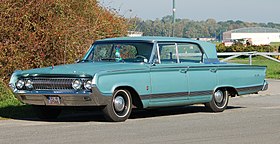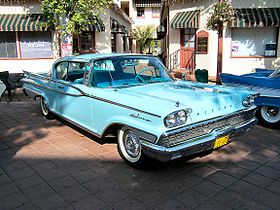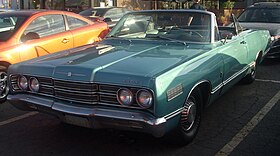Mercury Park Lane
| Mercury Park Lane | |
|---|---|
 1964 Mercury Park Lane four-door hardtop (with Breezeway Design roofline) | |
| Overview | |
| Manufacturer | Mercury (Ford) |
| Production | 1958–1960 1964–1968 |
| Body and chassis | |
| Class | Full-size |
| Layout | FR layout |
The Mercury Park Lane is a full-sized automobile that was produced by the Mercury division of Ford Motor Company. While not officially introduced as the replacement of the Mercury Turnpike Cruiser, the Park Lane became the flagship of the Mercury model line upon its introduction. The second-generation Park Lane was positioned above the Mercury Montclair.
In 1969, the Mercury Marquis was expanded to a full model line and replaced the Park Lane in the Mercury range.
First use of name[]
In 1956, the Park Lane name was used by the Ford Division as it created a two-door station wagon intended as a competitor for the Chevrolet Nomad. Based on the Ford Fairlane, the Ford Parklane (spelled as a single word) outsold the Nomad nearly two-to-one, though Ford marketers felt the vehicle had missed its target market; it was discontinued after its only year of production.
First generation (1958-1960)[]
| First generation | |
|---|---|
 1959 Mercury Park Lane two-door hardtop cruiser | |
| Overview | |
| Model years | 1958–1960 |
| Assembly | Metuchen, New Jersey Pico Rivera, California |
| Body and chassis | |
| Body style | 2-door hardtop coupe 2-door convertible 4-door hardtop sedan |
| Layout | FR layout |
| Related | Mercury Colony Park Edsel Citation |
| Powertrain | |
| Engine | 430 cu in (7.0 l) Ford MEL V8 |
| Transmission | 3-speed Merc-O-Matic |
| Dimensions | |
| Wheelbase | 125.0 in (3,175 mm) 126.0 in (3,200 mm) 128.0 in (3,251 mm) |
| Length | 220.2 in (5,593 mm) |
| Width | 81.1 in (2,060 mm) |
| Curb weight | 4,560 lb (2,070 kg) |
The Mercury Park Lane was introduced for the 1958 model year as a premium model line for the division. In design, it was conceptualized as a Super Mercury that would compete with General Motors' Buick Invicta and Chrysler 300D. Available in two-door and four-door hardtops and two-door convertibles, the Park Lane offered the same body styles as the Turnpike Cruiser, though its distinctive "breezeway" rear window was adopted by the Continental Mark line.[1]
Sharing its chassis with the Colony Park station wagon (and Edsel Citation/Corsair), the Park Lane had a 125-inch wheelbase (3 inches longer than the standard Mercury chassis). In 1959, the Park Lane wheelbase was stretched to 128 inches (two inches longer than other Mercurys). For 1960, the Park Lane wheelbase was again changed, matching the 126 inches of the standard Mercury line.
The Park Lane was powered by a single engine: a 430 cubic-inch Ford MEL V8. Initially rated at 360 hp for 1958, the Super Marauder engine option package allowed any Mercury with the 430 to increase its output to 400 hp (the first mass-production engine in an American automobile to be so rated). For 1959, the Super Marauder was discontinued, with the standard engine rated at 345 hp, retuned to 310 hp in 1960. All Park Lanes were equipped with a three-speed Merc-O-Matic automatic transmission.
For 1960, the Park Lane had a minor styling update distinguished by new taillamps, rear fender skirts, five chrome-accent bars ahead of the rear wheel openings, wide rocker panel moldings, and a padded dashboard.
In 1961, the Park Lane name was dropped (along with the Montclair) as the division reorganized its marketing efforts towards the better-selling Monterey alongside the introduction of the Mercury Comet compact.

A 1958 Mercury Park Lane Phaeton sedan

1959 Mercury Park Lane convertible

1959 Mercury Park Lane two-door hardtop cruiser

1960 Mercury Park Lane two-door hardtop cruiser
Second generation (1964-1968)[]
| Second generation | |
|---|---|
 1967 Mercury Park Lane convertible | |
| Overview | |
| Model years | 1964–1968 |
| Assembly | Hazelwood, Missouri (St. Louis Assembly Plant) Pico Rivera, California (Los Angeles Assembly) Hapeville, Georgia (Atlanta Assembly) |
| Body and chassis | |
| Body style | 4-door sedan 2-door Hardtop 2-door convertible 4-door Hardtop |
| Layout | FR layout |
| Powertrain | |
| Engine | 410 cu in (6.7 l) V8 428 cu in (7.0 l) V8 |
| Dimensions | |
| Wheelbase | 120.0–123.0 in (3,048–3,124 mm) |
| Length | 215.0–218.5 in (5,461–5,550 mm) |
| Width | 81.1 in (2,060 mm) |
| Curb weight | 4,171–4,211 lb (1,892–1,910 kg) |
For the 1964 model year, the Mercury Park Lane made its return as the Mercury Division expanded its model line. Above the Monterey and newly reintroduced Montclair, the Park Lane again topped the Mercury line. In contrast to the previous generation, the Park Lane used the same wheelbase as other Mercury lines, differing primarily in trim.
As the highest-priced, premium trim, many Park Lanes were fitted with the option of a "breezeway" reverse-slant retractable rear window (first used on the Turnpike Cruiser and the 1958-1960 Continental). In addition, Mercury offered the Park Lane with a fastback roofline as part of Marauder option package (seen on any full-sized Mercury); the fastback design proved popular on its Ford Galaxie 500 counterpart.
For 1965, the chassis of full-sized Ford and Mercury cars were redesigned; the Mercury line was given a much more slab-sided appearance. For 1967, to complement the Mercury Marquis (available only as a two-door hardtop), the Park Lane Brougham was introduced as a submodel of the Park Lane. For an option on hardtop coupe/convertible models, the Brougham introduced "yacht deck paneling" body trim (essentially the same simulated woodgrain DI-NOC used for the Colony Park); "yacht deck paneling" was a rarely ordered option.
As the division redesigned its full-sized line for 1969, the Marquis was expanded to a full model range, taking over the place of the Park Lane (the Brougham was largely replaced by the later Grand Marquis).

1964 Mercury Park Lane four-door hardtop ("Marauder" fastback roofline)

1965 Mercury Park Lane two-door hardtop
1966 Mercury Park Lane two-door hardtop

1967 Mercury Park Lane two-door hardtop
Mercury Park Lane Brougham[]
This section does not cite any sources. (October 2006) |
| Mercury Park Lane Brougham | |
|---|---|
 | |
| Overview | |
| Manufacturer | Ford Motor Company |
| Production | 1967–1968 |
| Body and chassis | |
| Body style | 4-door sedan 4-door hardtop 2-door fastback (1968 only) |

The Park Lane Brougham was the Ford Motor Company's flagship Mercury model during its two-year run from 1967 to 1968. Powerful and luxurious, it was offered as a four-door sedan, a four-door hardtop, and quite rarely, as a two-door hardtop (1968 only). The Brougham differentiated itself from the standard Park Lane by featuring 50–50 split bench seats with deep foam and thick box pleating, upscale door panels with higher trim levels and pull straps, and unique ornamentation.
Use in media[]
In the 1968-1980 CBS crime drama Hawaii Five-O, Jack Lord's character Steve McGarrett frequently drove a triple-black 1968 Mercury Park Lane Brougham four-door hardtop.
Alan Arkin's character "Gunny" Rafferty drives a run-down edition in Rafferty and the Gold Dust Twins
References[]
- ^ Flory Jr., J. "Kelly" (2008). American Cars, 1946-1959 Every Model Every Year. McFarland & Company, Inc., Publishers. ISBN 978-0-7864-3229-5.
- Mercury vehicles
- Full-size vehicles
- Motor vehicles manufactured in the United States
- Rear-wheel-drive vehicles
- Hawaii Five-O








